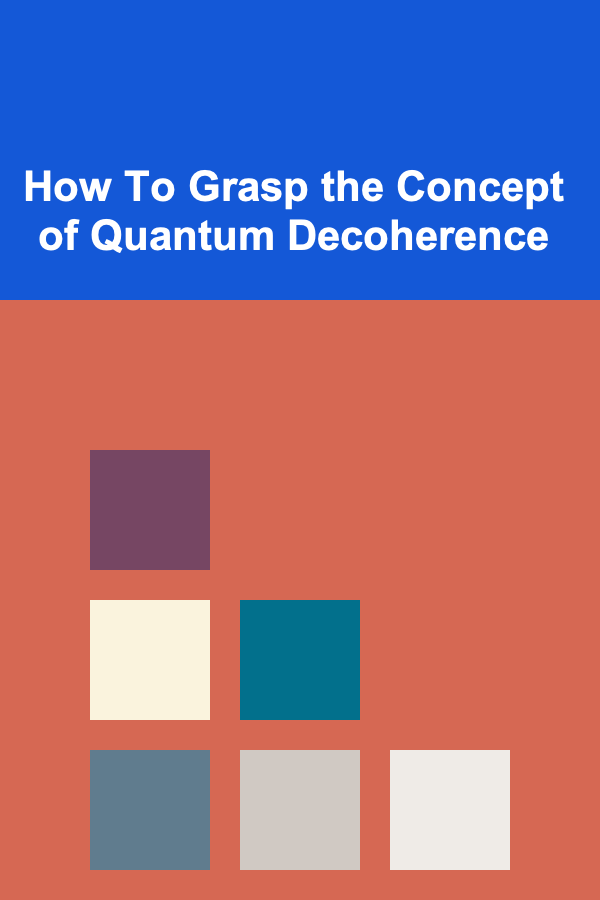
How To Grasp the Concept of Quantum Decoherence
ebook include PDF & Audio bundle (Micro Guide)
$12.99$7.99
Limited Time Offer! Order within the next:

Quantum mechanics, the theory that governs the behavior of the smallest particles in the universe, has long fascinated physicists, philosophers, and anyone interested in the fundamental workings of nature. One of the most puzzling aspects of quantum mechanics is the phenomenon of quantum decoherence. This concept, which lies at the intersection of quantum mechanics, classical physics, and philosophy, has profound implications for our understanding of the universe.
In this article, we will explore quantum decoherence in detail, providing a deep and accessible understanding of the topic. We will cover its fundamental principles, its role in quantum theory, its connection to the measurement problem, and its practical implications for quantum computing and our broader understanding of reality.
What Is Quantum Decoherence?
At its core, quantum decoherence refers to the process by which a quantum system loses its quantum coherence---meaning that its quantum superposition of states transitions into a more classical-like state. In simpler terms, decoherence explains how quantum systems, which can exist in multiple states at once (in a superposition), seem to "collapse" into a single state when observed or measured.
To understand this, we need to recall one of the strangest and most fundamental aspects of quantum mechanics: superposition. In the quantum world, particles like electrons or photons do not have well-defined states until they are measured. Instead, they exist in a superposition, which is a combination of all possible states. For example, an electron can exist in multiple positions or have multiple energy levels at the same time.
However, when we observe or measure the system, it "chooses" one of these possibilities. This transition from a superposition of states to a definite state is often referred to as wavefunction collapse, a process that quantum mechanics still struggles to explain fully.
Quantum decoherence offers a solution to part of this mystery. It suggests that the interaction of a quantum system with its environment---such as the surrounding particles, electromagnetic fields, or even the measuring device itself---leads to a loss of coherence between the different components of the system's wavefunction. As a result, the quantum system no longer behaves as a superposition of states but instead behaves in a way that is consistent with classical physics.
This explanation does not necessarily solve the measurement problem entirely, but it offers a crucial understanding of how classical reality emerges from quantum systems. In essence, quantum decoherence explains why we do not observe quantum superpositions in everyday life and how the classical world emerges from the quantum realm.
The Role of Environment in Quantum Decoherence
Quantum systems do not exist in isolation. They are constantly interacting with their surroundings, whether it be air molecules, electromagnetic radiation, or even the measurement devices used to observe them. These interactions play a central role in the process of decoherence.
In the context of quantum mechanics, we often refer to the environment as the collection of all external factors that influence the system. When a quantum system interacts with the environment, the coherence of the superposition is disrupted. This is because the environment effectively "measures" the system in many different ways, entangling the system with a large number of environmental states. This process increases the system's entropy, meaning that information about the system's state becomes increasingly inaccessible.
As the system becomes entangled with the environment, the quantum superposition of states effectively "decoheres" into a classical probability distribution. This means that the system behaves in a way that can be described using classical physics, even though it originated in a quantum state.
The mathematical description of decoherence involves the concept of density matrices. In quantum mechanics, a pure state is described by a wavefunction, which represents a superposition of possible states. When decoherence occurs, the pure state evolves into a mixed state, which can no longer be described by a single wavefunction but instead by a statistical mixture of different possibilities.
Example: Schrödinger's Cat
One of the most famous thought experiments in quantum mechanics is Schrödinger's cat, a scenario proposed by physicist Erwin Schrödinger in 1935. In this thought experiment, a cat is placed in a sealed box with a radioactive atom, a Geiger counter, and a vial of poison. If the atom decays, the Geiger counter triggers the release of the poison, killing the cat. If the atom does not decay, the cat remains alive.
According to quantum mechanics, the radioactive atom can be in a superposition of decayed and undecayed states until it is measured. Consequently, the cat, being entangled with the atom, is also in a superposition of alive and dead states. This leads to the strange conclusion that the cat is both alive and dead until the box is opened and the cat is observed.
However, quantum decoherence provides a solution to this paradox. The interaction between the quantum system (the radioactive atom) and the environment (such as the air molecules inside the box) causes decoherence. As a result, the superposition of the atom's states collapses into one definite state---either decayed or undecayed. This leads to a situation where, from the perspective of an external observer, the cat is either alive or dead, not both.
Thus, decoherence explains why we do not observe superpositions of macroscopic objects like cats in the real world. The environment causes the system to lose its coherence and behave in a way consistent with classical physics.
Decoherence and the Measurement Problem
The measurement problem in quantum mechanics is one of the most controversial and unresolved issues in the field. It asks the question: Why does the act of measurement cause a quantum system to "choose" a specific state from the superposition?
Some interpretations of quantum mechanics, such as the Copenhagen interpretation , propose that the wavefunction collapses when a measurement is made, but they do not provide a detailed explanation of how or why this collapse occurs. Others, like the many-worlds interpretation, suggest that all possible outcomes of a quantum measurement actually occur, each in a different "branch" of the universe.
Quantum decoherence offers an explanation that is often seen as a middle ground between these two interpretations. According to the decoherence view, the act of measurement is not a special event in itself but is instead part of the natural process of interaction between the quantum system and its environment. As the system becomes entangled with the environment, the superposition of states becomes effectively "measured" by the environment, causing the system to behave as if it has collapsed into one of the possible states.
This perspective does not entirely solve the measurement problem, but it does explain why we do not observe superpositions in macroscopic systems. In the everyday world, the interactions between objects and their environment happen so frequently and at such a large scale that quantum coherence is lost almost instantaneously. This makes it appear as though the system "chooses" a definite state when observed, even though the underlying process is more complex.
Quantum Decoherence and Classical Physics
One of the most fascinating implications of quantum decoherence is its role in the transition from the quantum world to the classical world. In classical physics, objects have well-defined positions and velocities, and their behavior is predictable. However, in the quantum world, particles can exist in superpositions of states, making it difficult to predict their exact behavior.
Quantum decoherence helps explain how the classical world emerges from the quantum realm. When a quantum system interacts with its environment, it loses its coherence and behaves more like a classical system. This process explains why we do not observe quantum effects in everyday life. The interactions with the environment ensure that systems quickly lose their quantum properties, and their behavior becomes consistent with classical physics.
This idea is closely related to the concept of classicality. Classical systems are those that do not exhibit quantum superposition or interference effects, and their behavior can be described using classical mechanics. Decoherence provides a mechanism for how quantum systems become classical through their interaction with the environment.
Decoherence and Quantum Computing
One of the most exciting applications of quantum mechanics is in the field of quantum computing . Quantum computers leverage the principles of superposition and entanglement to perform calculations that would be infeasible for classical computers. However, quantum computers face a major challenge: decoherence.
In a quantum computer, qubits are the quantum analog of classical bits. Unlike classical bits, which can only be in one of two states (0 or 1), qubits can exist in a superposition of both 0 and 1. This allows quantum computers to perform many calculations simultaneously. However, decoherence is a major obstacle to building large-scale quantum computers because the delicate quantum states of qubits are easily disturbed by the environment.
Researchers are actively working on ways to mitigate the effects of decoherence in quantum computing. One promising approach is the development of quantum error correction techniques, which aim to protect quantum information from the effects of decoherence. Additionally, quantum systems need to be kept at extremely low temperatures to minimize interactions with the environment and reduce the rate of decoherence.
Conclusion
Quantum decoherence is a central concept in our understanding of the quantum-to-classical transition. It explains why we do not observe quantum superpositions in everyday life and provides a mechanism for the emergence of classical behavior from quantum systems. Although decoherence does not solve the measurement problem entirely, it offers important insights into how quantum systems interact with their environment, leading to the classical reality we observe.
As we continue to explore the frontiers of quantum mechanics and quantum computing, decoherence will play an essential role in shaping our understanding of the universe. Through ongoing research and experimentation, we are likely to gain even deeper insights into this fascinating phenomenon, and its implications for technology and our understanding of the cosmos.

Cutting Down on Wedding Guest Expenses: Tips for Enjoying the Big Day Without Breaking the Bank
Read More
How to Keep Your Closet Organized All Year Round
Read More
Mastering Clinical Research Coordination: Best Practices for Successful Trials
Read More
The Supply Chain Manager's Guide: Optimizing Efficiency and Reducing Costs
Read More
How to Build a Living Roof
Read More
Understanding the Future of AR: A Deep Dive
Read MoreOther Products

Cutting Down on Wedding Guest Expenses: Tips for Enjoying the Big Day Without Breaking the Bank
Read More
How to Keep Your Closet Organized All Year Round
Read More
Mastering Clinical Research Coordination: Best Practices for Successful Trials
Read More
The Supply Chain Manager's Guide: Optimizing Efficiency and Reducing Costs
Read More
How to Build a Living Roof
Read More